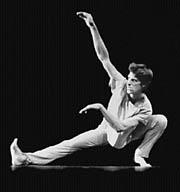HE MAY SING and dance, but Christian Swenson isn’t a traditional song-and-dance man. As he slides through his idiosyncratic material hooting raucously or keening with imagined pain, Swenson is far away from the world of George M. Cohan or Gene Kelly. This could be the song and dance of another species—or another planet.
Christian Swenson
Chamber Theater, June 15-18
Swenson has been embodying these other people and places for over 20 years. An apprenticeship in the 1970s with the Bill Evans Dance Company brought him to Seattle, where he has continued to expand his definitions of what dance and music might be. He began vocalizing while dancing, first with that repertoire of percussive sound effects familiar to young boys playing army. Over time he began to push the edges of that personal soundtrack, finding the places where sounds become music, shifting pitches or textures or durations to move beyond their original functional sources. Combining this experimentation with his background in mime and improvisation, Swenson has developed a style that mediates between dancing and singing.
Reflecting the interconnectedness of these activities, Swenson calls his performance practice “dansing.” As he describes it, singing and dancing are both grounded in movement, and performing both together increases their possibilities. Dancers are often judged on their musicality, their ability to physicalize the shape and dynamics of a musical phrase. In this case, however, the dancing is helping to create the music, not merely illustrate it. For those of us whose coordination skills were challenged by high-school marching band, this is heady stuff.
CITING JEAN GENET’S tenet that “imitation is love,” Swenson enthusiastically tries on material from different species as well as different cultures. In his signature piece Devolution, he transforms from human to amoeba with stops at monkey, lizard, and fish along the way. Even within the human category he shifts easily from old to young, male to female, garrulous to reticent, supported by vocalizations that only occasionally use English words but almost always seem to have actual meaning. In his own way, he’s telling stories without words and without literal gestures.
The specific quality of Swenson’s movement resembles the intricate sign language of Indian mudras or orchestra conductors, but these are not traditional mime exercises, which replicate natural activities with all the props removed. He pays the same attention to rhythm as tap dancers do, but in his case the articulation is spread through the entire body rather than centered in the legs and feet. In each piece Swenson creates a particular grammar of sound and action, close enough to our own experience to be intelligible but full of references to other worlds, real or imaginary.
As he has developed his approach to performance, Swenson has found himself outside of traditional dance and music categories. But as he says in the liner notes to Off-Road Vocals, the CD he recorded recently, he prefers to work off the regular pathways, his own kind of song-and-dance man.








